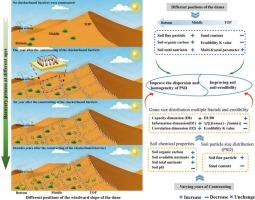Decadal effects of checkerboard barriers of Salix psammophila on soil grain size distribution and erodibility
IF 5.7
1区 农林科学
Q1 GEOSCIENCES, MULTIDISCIPLINARY
引用次数: 0
Abstract
In arid and semi-arid regions of the world, checkerboard barriers of Salix psammophila play a key role in ecological restoration. However, the effects of different ages of checkerboard barriers on soil particle size distribution characteristics and soil erosion resistance are not known. For this study, sand dunes with checkerboard barriers of S. psammophila were selected as the study population, and mobile dunes prior to checkerboard barriers of S. psammophila were used as unconstructed sample plots (CK). We collected soil from the top, middle, and bottom in 0–2 cm soil layers of the dunes unconstruct and under one year (1a), six years (6a), and decade years (10a) of checkerboard barriers of S. psammophila, respectively. We used multiple fractal theory and erodibility K value to reveal the characteristics of soil grain size distribution and erodibility by checkerboard barriers of S. psammophila and elucidated their main influencing factors. Compared with CK, the construct checkerboard barriers of S. psammophila significantly increased soil nutrients and fine particle content with increasing age. In addition, checkerboard barriers altered the distribution patterns of soil nutrients and particle size in different parts of the dunes, with nutrients and fine particles mainly concentrated at the bottom of the dunes. Checkerboard barriers of S. psammophila reduced the width of the soil particle size distribution relative to CK at 1a of construction, but they incresed the dispersion and homogeneity of the soil particle size distribution as the number of years of construction increased. The soil erodibility K values were found to be between 0.087–0.101, 0.083–0.090, 0.068–0.075, and 0.066–0.069 for CK, 1a, 6a, and 10a, respectively. A random forest model identified soil nutrients, grain size composition, multifractal parameters (D1 and D1/D0), and vegetation characteristics as the key factors influencing K values (P < 0.05, R2 = 0.902).

沙柳棋盘状屏障对土壤粒度分布和可蚀性的年代际影响
在世界干旱和半干旱地区,沙柳的棋盘状屏障在生态恢复中起着关键作用。然而,不同年龄的棋盘格屏障对土壤粒度分布特征和土壤抗侵蚀能力的影响尚不清楚。本研究选择具有沙棘棋盘状屏障的沙丘作为研究群体,以沙棘棋盘状屏障之前的流动沙丘作为未构建样地(CK)。我们分别在沙丘未建筑的0-2 cm土层的顶部、中部和底部,以及沙柳草棋盘状屏障1年(1a)、6年(6a)和10年(10a)内采集土壤。利用多重分形理论和可蚀性K值,揭示了沙土沙土的粒度分布和可蚀性特征,并阐明了其主要影响因素。与对照相比,随着树龄的增加,沙棘草棋盘状结构屏障显著提高了土壤养分和细粒含量。此外,棋盘状屏障改变了沙丘不同部位土壤养分和粒度的分布格局,养分和细粒主要集中在沙丘底部。沙棘棋盘状屏障在建设1a时降低了土壤粒径分布的宽度,但随着建设年限的增加,沙棘棋盘状屏障增加了土壤粒径分布的分散性和均匀性。CK、1a、6a和10a土壤可蚀性K值分别为0.087 ~ 0.101、0.083 ~ 0.090、0.068 ~ 0.075和0.066 ~ 0.069。随机森林模型发现土壤养分、粒度组成、多重分形参数(D1和D1/D0)和植被特征是影响K值的关键因素(P < 0.05, R2 = 0.902)。
本文章由计算机程序翻译,如有差异,请以英文原文为准。
求助全文
约1分钟内获得全文
求助全文
来源期刊

Catena
环境科学-地球科学综合
CiteScore
10.50
自引率
9.70%
发文量
816
审稿时长
54 days
期刊介绍:
Catena publishes papers describing original field and laboratory investigations and reviews on geoecology and landscape evolution with emphasis on interdisciplinary aspects of soil science, hydrology and geomorphology. It aims to disseminate new knowledge and foster better understanding of the physical environment, of evolutionary sequences that have resulted in past and current landscapes, and of the natural processes that are likely to determine the fate of our terrestrial environment.
Papers within any one of the above topics are welcome provided they are of sufficiently wide interest and relevance.
 求助内容:
求助内容: 应助结果提醒方式:
应助结果提醒方式:


